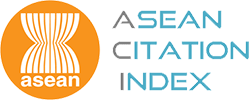HAT-RAPD Fingerprinting Analysis of Thai Cassava Germplasm and Economic Cultivars of Farmers’ Preferences
Keywords:
มันสำปะหลัง, แหล่งเชื้อพันธุกรรมมันสำปะหลัง, เทคนิค HAT-RAPD, วิธี UPGMAAbstract
บทคัดย่อการศึกษาความหลากหลายทางพันธุกรรมของมันสำปะหลัง (Manihot esculenta Crantz) จำนวน 19 พันธุ์ปลูก โดยใช้เทคนิค high annealing temperature-random amplified polymorphic DNA (HAT-RAPD) ประกอบด้วยพันธุ์ปลูกที่ได้จากแหล่งเชื้อพันธุกรรมของศูนย์วิจัยพืชไร่ระยอง 16 พันธุ์ปลูก และพันธุ์ปลูกซึ่งเป็นที่นิยมของเกษตรกร 3 พันธุ์ปลูกจากจังหวัดนครราชสีมา ในการใช้ไพรเมอร์แบบสุ่มทั้งหมด 28 ไพรเมอร์ พบว่า 21 ไพรเมอร์ให้แถบดีเอ็นเอที่มีความแตกต่าง เมื่อวิเคราะห์ความต่างทางพันธุกรรมของพันธุ์ปลูกแต่ละคู่โดยใช้ Nei’s genetic distance พบว่ามีความแตกต่างตั้งแต่ 3 ถึง 82% นอกจากนี้เดนโดรแกรมแสดงความสัมพันธ์ทางพันธุกรรมของมันสำปะหลังที่ศึกษาด้วย unweighted pair group method with arithmetic mean (UPGMA) จากแถบดีเอ็นเอที่มีความแตกต่างจำนวน 61 แถบ สามารถจัดกลุ่มทั้ง 19 พันธุ์ปลูก เป็น 5 กลุ่ม โดยแบ่งเป็นตัวอย่างของพันธุ์ขมจำนวน 4 กลุ่ม และพันธุ์หวานจำนวน 1 กลุ่ม ภายในกลุ่มของพันธุ์ขมพบ 3 พันธุ์ปลูกเศรษฐกิจที่นิยมโดยเกษตรกร ได้แก่ พันธุ์เกล็ดมังกร (มีความสัมพันธ์ใกล้ชิดกับพันธุ์ระยอง 72) พันธุ์ไจแอนท์ (จัดอยู่ในกลุ่มเดียวกันกับพันธุ์ห้วยบง 60 และพันธุ์ห้วยบง 80) และพันธุ์นาคขาว (จัดอยู่ในกลุ่มเดียวกันกับพันธุ์ระยอง 3 และพันธุ์ระยอง 5) คำสำคัญ: มันสำปะหลัง แหล่งเชื้อพันธุกรรมมันสำปะหลัง เทคนิค HAT-RAPD วิธี UPGMAABSTRACTSixteen cultivars of cassava (Manihot esculenta Crantz) were obtained from the germplasm collection in Rayong Field Crops Research Center, and three other economic cultivars of farmers’ preferences from a well-established cassava plantation in Nakhon Ratchasima. Genetic diversity of these nineteen cultivars was assessed by high annealing temperature-random amplified polymorphic DNA (HAT-RAPD) technique. Out of 28 random primers used, 21 generated polymorphic bands. Pairwise distances between taxa calculated using Nei’s genetic distance varied from 3 to 82%. An unweighted pair group method with arithmetic mean (UPGMA) dendrogram constructed based on 61 RAPD characters classified all 19 cultivars into five clusters, four of which containing bitter-type accessions and one accommodating sweet-type accessions. The bitter-type clusters possessed three cultivars of farmers’ preferences, including Gled Mangorn (closely related to Rayong 72), Giant (placed with Huay Bong 60 and Huay Bong 80), and Nak Khao (placed with Rayong 3 and Rayong 5).Keywords: Manihot esculenta Crantz, cassava germplasm, HAT-RAPD technique, UPGMA methodDownloads
Download data is not yet available.
Downloads
Published
2019-06-25
How to Cite
Rangsiruji, A., Pringsulaka, O., & Binchai, S. (2019). HAT-RAPD Fingerprinting Analysis of Thai Cassava Germplasm and Economic Cultivars of Farmers’ Preferences. Science Essence Journal, 35(1), 59–74. Retrieved from https://ejournals.swu.ac.th/index.php/sej/article/view/10444
Issue
Section
Research Article








